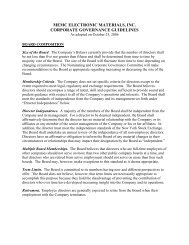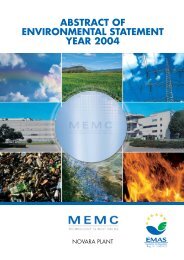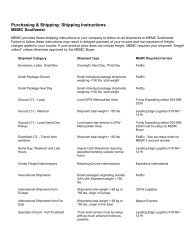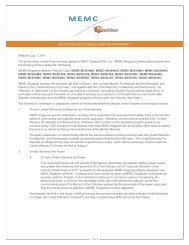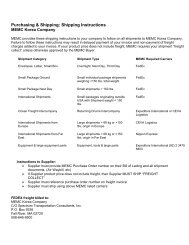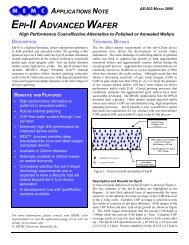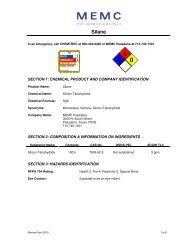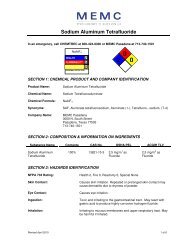BUILDING ON THE PAST, READY FOR THE FUTURE: - MEMC
BUILDING ON THE PAST, READY FOR THE FUTURE: - MEMC
BUILDING ON THE PAST, READY FOR THE FUTURE: - MEMC
You also want an ePaper? Increase the reach of your titles
YUMPU automatically turns print PDFs into web optimized ePapers that Google loves.
diameter silicon wafers. We will also begin<br />
building for the future by proceeding immediately<br />
with plans to construct a new facility for 200mm<br />
wafers for both TI and general market demands.”<br />
That expansion came to fruition in 1997 and<br />
represented an investment of almost $300 million.<br />
This freed up <strong>MEMC</strong> Southwest’s existing<br />
manufacturing facility for the captive production<br />
of TI’s smaller diameter wafer requirements.<br />
MeMC, InC.: a gloBal CoMPany<br />
Through its joint ventures and other alliances,<br />
<strong>MEMC</strong> implemented a process whereby localized<br />
sourcing and technical service provided significant<br />
competitive advantages. <strong>MEMC</strong>’s geographically<br />
diverse production network allowed the company<br />
to service the world’s key semiconductor<br />
markets while remaining close, strategically and<br />
geographically, to its most important asset—the<br />
customer. Other than the Korean Plan, which is 20<br />
percent owned by Samsung, currently, all original<br />
joint ventures are 100 percent <strong>MEMC</strong> owned and<br />
operated.<br />
Fifty years after its inception as a pioneering<br />
plant in St. Peters, Missouri, <strong>MEMC</strong> Electronic<br />
Materials, Inc., remains a global leader in the<br />
silicon wafer industry. With a worldwide network<br />
for manufacturing polysilicon, wafer production,<br />
and finishing, <strong>MEMC</strong>’s scope is truly global.<br />
the large-sCale IntegratIon (lsI) era<br />
When first developed, integrated circuits<br />
contained only a few transistors. Referred to as<br />
small-scale integration or SSI, they used circuits<br />
containing transistors numbering in the tens. By<br />
the late 1960s, devices contained hundreds of<br />
transistors on each chip, called medium-scale<br />
integration or MSI. The mid-1970s ushered in the<br />
era of large-scale integration or LSI with tens of<br />
thousands of transistors per chip. Predictably, the<br />
next generation, starting in the 1980s, was that<br />
of Very Large-Scale Integration or VLSI, using<br />
Double side wafer grinder at <strong>MEMC</strong> Southwest’s modifications<br />
area, April 1997.<br />
First completed crystal at <strong>MEMC</strong> Southwest, December 1996.<br />
hundreds of thousands of transistors. The term<br />
VLSI has since been supplanted by ULSI or Ultra<br />
Large-Scale Integration to refer to an integrated<br />
circuit with more than one million components<br />
per chip.<br />
Each successive generation of IC capacity requires<br />
increasing levels of perfection in silicon wafer<br />
technology. Throughout the 1990s, <strong>MEMC</strong><br />
developed silicon wafers that provided optimal<br />
solutions for VLSI-era device manufacturers and<br />
A Global Company 57



